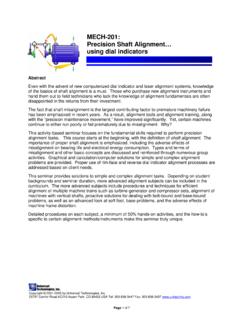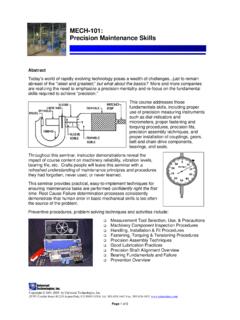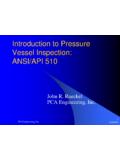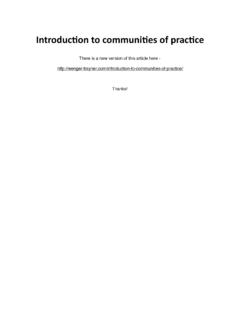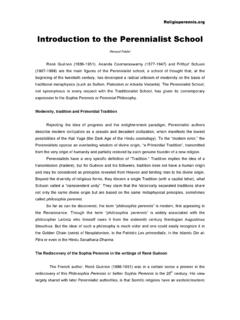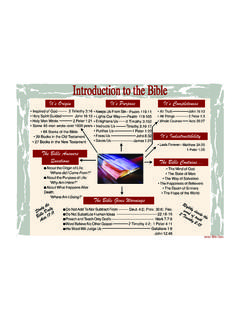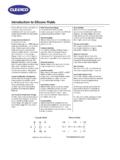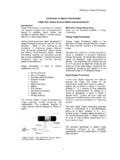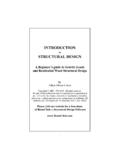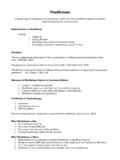Transcription of An Introduction to Time Waveform Analysis
1 Copyright 1999 Universal Technologies, Inc. 25797 Conifer Road #C210 Aspen Park, CO 80433 Tel: 303-838-3447 Fax: 303-838-3437 An Introduction to Time Waveform Analysis Timothy A Dunton, Universal Technologies Inc. Abstract In recent years there has been a resurgence in the use of time Waveform Analysis techniques. Condition monitoring personnel have now come to realize some of the limitations of the FFT process. Since many find the time Waveform Analysis process difficult and confusing the technique is rarely used to its full potential. The key to the successful utilization of time Waveform data is knowing when to use it. This paper examines the limitations of the FFT process and identifies specific applications where enhancing FFT information with time Waveform Analysis is appropriate.
2 The paper also details in practical terms how to set up, acquire and manipulate time Waveform data. Having discussed the acquisition of the data the paper continues to discuss the interpretation of the data including the time-frequency relationship, symmetry, and pattern recognition of common faults. Biography Timothy A. Dunton Vice President Product Development Born and Educated in the UK, Tim spent 14 years with Shell Tankers UK. Ltd. as a marine engineer, serving on Oil and LNG tankers in a variety of positions including Cargo Engineer. After emigrating to Canada Tim brought his practical experience to IRD Mechanalysis as a Consulting Service Engineer, providing training, software support and on site Analysis services throughout Canada.
3 In 1991 Tim joined Update International as a senior instructor where he conducted various vibration and skills related courses in both the public and in-plant arenas throughout the world. During his tenure at Update Tim assisted in development of several seminars in the subjects of vibration Analysis , machinery skills and bearings. Tim was also responsible for upgrading several seminars and developing award winning multimedia interactive software. Tim is a regular speaker at various maintenance conferences throughout the world. Now with Universal Technologies, Tim s primary responsibility is in the area of multimedia product development but he continues to be active in the teaching arena. Copyright 1999 Universal Technologies, Inc.
4 25797 Conifer Road #C210 Aspen Park, CO 80433 Tel: 303-838-3447 Fax: 303-838-3437 Introduction The Analysis of time Waveform data is not a new technique. In the early days of vibration Analysis time Waveform data was viewed on oscilloscopes and frequency components calculated by hand. The relationship between frequency and time is as follows: f = 1/p where: f is the frequency in Hz p is the period in seconds (the amount of time required to complete 1 cycle) Knowledge of this relationship permits the determination of frequency components from the raw Waveform data. Amplitude Time Period Copyright 1999 Universal Technologies, Inc. 25797 Conifer Road #C210 Aspen Park, CO 80433 Tel: 303-838-3447 Fax: 303-838-3437 For example: The above Waveform was acquired from a 1785 RPM pump.
5 The time spacing between the impacts is seconds. From this information the frequency can be determined. f = 1/p = 1 / = Hz = 1780 CPM This indicates that the impact is occurring at a frequency of 1 x RPM. In most situations the time Waveform pattern is very complex as illustrated below and therefore the determination of frequency components is extremely difficult using this method and is not recommended. Copyright 1999 Universal Technologies, Inc. 25797 Conifer Road #C210 Aspen Park, CO 80433 Tel: 303-838-3447 Fax: 303-838-3437 In most situations time Waveform data is best utilized by applying the principles of pattern recognition and if necessary calculating the frequency components of the major events in the Waveform pattern.
6 When to Use Time Waveform Time Waveform can be used effectively to enhance spectral information in the following applications: Low speed applications (less than 100 RPM). Indication of true amplitude in situations where impacts occur such as assessment of rolling element bearing defect severity. Gears. Sleeve bearing machines with X-Y probes (2 channel orbit Analysis ) Looseness. Rubs. Beats When NOT to Use Time Waveform Time Waveform can be applied to any vibration problem. In some situations normal spectral and phase data provide better indications as to the source of the problem without the added complexity of time Waveform data. Examples include Unbalance on normal speed machines Misalignment on normal speed machines Instrument Setup for Time Waveform The key to successful Analysis of time Waveform data is in the set up of the instrument.
7 The following items have to be considered when setting up the instrument Unit of measurement Time period sampled Resolution Averaging Windows Copyright 1999 Universal Technologies, Inc. 25797 Conifer Road #C210 Aspen Park, CO 80433 Tel: 303-838-3447 Fax: 303-838-3437 Units of Measurement Amplitude measurement units should be generally selected based upon the frequencies of interest. The plots below illustrate how measurement unit selection affects the data displayed. Each plot contains 3 separate frequency components of 60Hz, 300Hz, and 950 Hz. This data was taken using displacement note how the lower frequency at 60 Hz is accentuated The same data is now displayed using velocity note how the 300Hz component is more apparent.
8 The same data is now displayed using acceleration note how the large lower frequency component is diminished and the higher frequency component accentuated. The unit of measurement displayed in time Waveform data should be the natural unit of the transducer used. For example if a displacement reading is required, then a displacement transducer should be used. In most cases where modern data collectors are employed this means that acceleration will be the unit of choice. If data is gathered from non-contact probes on sleeve bearing machines displacement is usually used. Copyright 1999 Universal Technologies, Inc. 25797 Conifer Road #C210 Aspen Park, CO 80433 Tel: 303-838-3447 Fax: 303-838-3437 Time Period Sampled For most Analysis work the instrument should be set up to see 6-10 revolutions of the shaft being measured.
9 The total sample period desired can be calculated by this formula Total sample period [seconds] = 60 x # of revolutions desired RPM The following table Illustrates common time period in seconds by machine speed Machine RPM Time period for 6 revolutions (secs.) Time period for 10 revolutions (secs.) 3600 1800 1200 900 300 100
10 Some instruments do not permit the setting of time period data when acquiring time Waveform data. With these instruments it is necessary to set an equivalent FMAX setting. The appropriate FMAX setting can be calculated by the following formula FMAX [CPM] = Lines of Resolution x RPM # Of Revolutions desired The following table Illustrates the common FMAX settings for 1600 lines of resolution by machine RPM Machine RPM FMAX for 6 revolutions FMAX for 10 revolutions 3600 960kCPM 576kCPM 1800 480kCPM 288kCPM 1200 320kCPM 192kCPM 900

